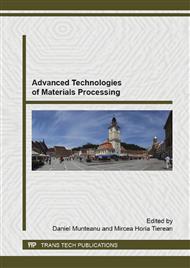[1]
R. Singh, A. Jain, S. Panwar, D. Gupta, S.K. Khare, Antimicrobial activity of some natural dyes, Dyes Pigm. 66 (2005) 99-102.
DOI: 10.1016/j.dyepig.2004.09.005
Google Scholar
[2]
J.V. Edwards, G. Buschle-Diller, S. C. Goheen, (Eds), Modified fibers with medical and specialty applications, Publisher Springer Netherlands, eBook ISBN 978-1-4020-3794-8, (2006).
DOI: 10.1007/1-4020-3794-5
Google Scholar
[3]
I.C. Gouveia, Nanobiotechnology, A new strategy to develop non-toxic antimicrobial textiles for healthcare applications, Special Abstracts/J Biotechnol 150S (2010) S349.
DOI: 10.1016/j.jbiotec.2010.09.387
Google Scholar
[4]
M. B. Kasiri, S. Safapour, Natural dyes and antimicrobials for green treatment of textiles, Environ. Chem. Lett. 12 (2014) 1-13.
DOI: 10.1007/s10311-013-0426-2
Google Scholar
[5]
M.P. Sathianarayanan, N.V. Bhat, S.S. Kokate, V.E. Walunj, Antimicrobial finish for cotton fabrics from herbal products, Indian J. Fibre Text. Res. 35 (2010) 50-58.
Google Scholar
[6]
P.S. Vankar, R. Shanker, S. Dixit, D. Mahanta, Sonicator dyeing of cotton, wool and silk with the leaves extract, J. Text App Technol Manag 6 (2009) 1-11.
DOI: 10.1108/03699420910957042
Google Scholar
[7]
A. Guesmi, N. Ladhari, F. Sakli, Ultrasonic preparation of cationic cotton and its application in ultrasonic natural dyeing, Ultrason. Sonochem. 20 (2013) 571-579.
DOI: 10.1016/j.ultsonch.2012.04.012
Google Scholar
[8]
P.S. Vankar, R. Shanker, J. Srivastava, Ultrasonic dyeing of cotton fabric with aqueous extract of Eclipta alba, Dyes Pigm. 72(1) (2007) 33-37.
DOI: 10.1016/j.dyepig.2005.07.013
Google Scholar
[9]
P.S. Vankar, R. Shanker, S. Dixit, Chemical characterisation of extract derived from Daphne papyraceae and sonicator dyeing of cotton, silk and wool with the extract, Pigm. Resin. Technol. 38(3) (2009)181-187.
DOI: 10.1108/03699420910957042
Google Scholar
[10]
P. S. Vankar, R. Shanker, S. Dixit, Sonicator dyeing of cotton with the leaves extract Acer pectinatum Wallich, Pigm. Resin Technol. 37(5) (2008) 308-313.
DOI: 10.1108/03699420810901981
Google Scholar
[11]
L. Cabrales, N. Abidi, A. Hammond, A. Hamood, Cotton Fabric Functionalization with Cyclodextrins, J. Mater. Environ. Sci. 3 (2012) 561-574.
Google Scholar
[12]
J. H. Wang, Z. S. Cai, Incorporation of the antibacterial agent, miconazole nitrate into a cellulosic fabric grafted with β-cyclodextrin, Carbohydr. Polym. 72 (2008) 695-700.
DOI: 10.1016/j.carbpol.2007.10.019
Google Scholar
[13]
T. Furuta, Y. Kusuya, T.L. Neoh, L. Rehmann, S.H. Beak, H. Yoshii, Inclusion and release of hinokitiol into/from MCT-β-CD fixed on Japanese washi paper, J. Incl. Phenom. Macrocycl. Chem. 56 (2006) 107-111.
DOI: 10.1007/s10847-006-9070-9
Google Scholar
[14]
D. Coman, S. Oancea, N. Vrînceanu, M. Stoia, Sonication and conventional dyeing procedures of flax fibres with Allium cepa anthocyanin extract, Cell. Chem. Technol. 48 (2014) 145-157.
Google Scholar
[15]
D. Coman, N. Vrinceanu, S. Oancea, Innovative eco-dyed composites obtained by inclusion procedure, Welding & Mat Testing 1 (2014) 17-20.
Google Scholar
[16]
I.A. Tan, A.L. Ahmad, B.H. Hameed, Adsorption of basic dye using activated carbon prepared from oil palm shell: Batch and fixed bed studies, Desalination. 225 (2008)13-28.
DOI: 10.1016/j.desal.2007.07.005
Google Scholar
[17]
C.H. Gilles, T.H. Macewan, S.N. Nakhwa, D. Smith, D., A system of classification of solution adsorption isotherms, and its use in diagnosis of adsorption mechanisms, J. Chem. Soc. 4 (1960) 3973-3993.
DOI: 10.1039/jr9600003973
Google Scholar
[18]
F. Rouquerol, J. Rouquerol, K.S.W. Sing, Adsorption by Powders and Porous Solids, Principles, Methodology and Applications, Academic Press, London, 1991, p.441.
DOI: 10.1016/b978-012598920-6/50004-x
Google Scholar


